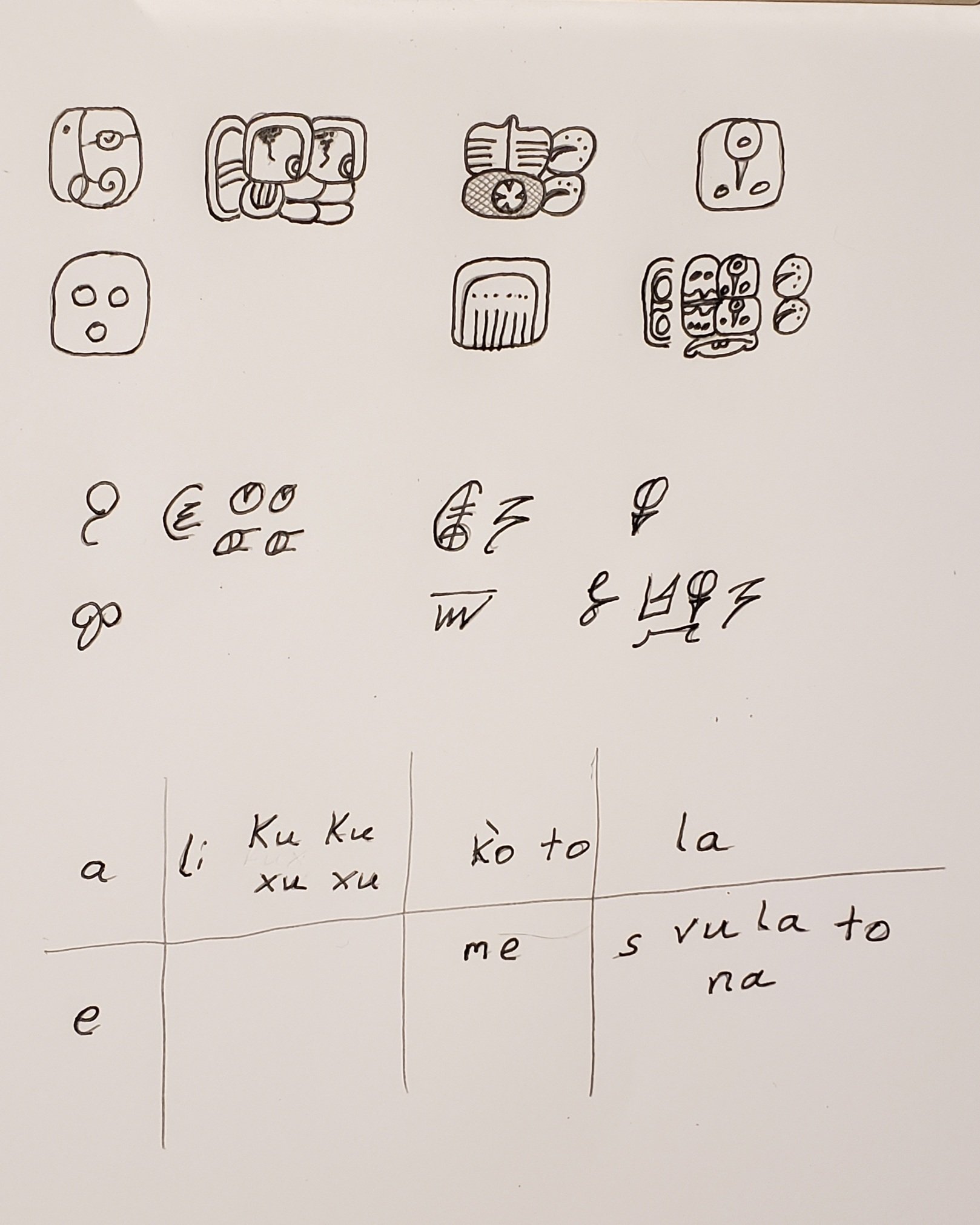Note: This is a work in progress and just a place holder for jotting my thoughts down.
Disclaimer: This should not be viewed as being a legitimate source of information, and just as something fun (and I do find it fun, 😊 ). As well as I am getting older, and my hardware is fairly outdated, and the programmers are a joke. So expect a lot of this to be the mere musings of a madman.
I will be updating this, eh, as much as I can. Anyway, let's do this thing.
I have had this idea of writing Tzotzil (as it's the only Mayan dialect I know well enough) with the Mayan characters, and the following are the rules that I am attempting to adhere to.
Basics
- Abide as much as possible with known Mayan rules and knowledge of their writing.
- Standardize and simplify the characters as much as possible as if they have continual use into a college setting, internet chatroom setting, written novels, mathematical texts, technical documentation, or children passing notes in grade school.
- If the need arises to create a character, use only what is known.
(And I've lost my train of thought for the moment. Ok, at least I got this part started).
What I'm working on at the moment is writing down the lyrics to Vayijel's "Kux Kux".

Top: Is a fancier writing and closer to the original Mayan.
Middle: Is a more simplistic shorthand which I am attempting to further simplify the codices written forms.
Bottom: Is a transliteration of the characters used.
Non Modified Characters
a, li, ku, to, la, e, me, na.
Modified Sounds of Known Mayan Characters (That follow Mayan rules).
- vu <= huun (Huun is the Yucatec word for paper, which is vun in Tzotzil).
- s <= u (u is the third person pronoun in Yucatec, and since there are several characters for the sound u, I repurposed one of those characters for s, which is the third person pronoun in Tzotzil).
Modified Characters of Known Mayan Characters (That do not follow Mayan rules).
- xu <= nuuk (I have found a 'xu' character in my "The New Catalog of Maya Nieroglyphs Vol. 2", but haven't implemented it as of yet).
- Since ku is spelled twice, I added an extra tail onto the character xu to reduplicate it across both ku characters.
- k'o <= o embedded with the letter k'i.
The final word "svulanot", is spelled "s vulan[a] to" with "s" and "to" as affixes separated by a space to the verb vulan[a], but this may change once I start making it possible to write these characters much smaller (as should be for written novels, text books, etc).
(Ok, I've spent what little brain power I've had...Man, I hope I can remember this...I really really enjoy this kind of thinking, heh).
(Also, if ya'll have any questions, just ask. Maybe it will help this aging mind to concentrate a bit better...Anything is possible, 🤣 ).
How did you come to be interested in Mayan languages? And how did you go about learning them?
By accident really. I found a book called "Of Cabbages and Kings, Tales from Zinacantan", and was able to decode a lot from both what little was explained in the book, and deducing from what I had learned from Cherokee. Then there was a web site called Sk'op Sotz'leb which went into more detail and had some pronunciations. After a few years I had gotten my hands on "The Great Tzotzil Dictionary of San Lorenzo Zinacantan" (And to this day it is my all time favorite translating dictionary. So much so that Robert M. Luaghlin is one of a very few people I revere).
It was kind of odd, as when I first started learning the language, I wasn't that keen into it. Heck, I really didn't like Cherokee all that well either. I found many Algonquian and Siouan languages to be far more prettier, but I actually found really good references for Tzotzil here...In this backward hillbilly hole in the ground, 😶 , and Cherokee through a mail order company. Anyway, the more I learned about the Tzotzil language, the more interesting it became, and the more I wanted to learn it.
Granted, I was never going to be fluent (just don't live in that kind of area), but I did surprise the only person I ever talked with who knew the language. So I didn't do all that bad. (The area I had the most difficulty with were the numbers, and that guy helped me to understand them. Actually, he helped me a lot. Tzotzil seems to count backwards after 20, but when you translate the words, it makes more sense. Jun scha'vinik = 21, but cha'vinik = 40. Which my mind always thought jun scha'vinik as 41, but once I learned to "translate" the numbers, jun scha'vinik : jun (one) s (3rd person possessive) cha' (two) vinik (man). "One [digit] of the second man" thus 21, as 20 is all the digits of the first man, and now we're counting the next digits of the next man).
Anyway, I can't get too descriptive. 24 years of a bad marriage, chronic pains, and dealing with some really harsh health issues, my mind is pretty darn wrecked, but I am hoping I can at least pull off some feats before it gets worse, HAH!